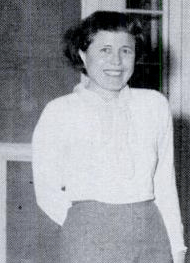Klara Dan von Neumann
| Klara Dan von Neumann | |
|---|---|
 Klara Dan von Neumann. Photo by Alfred Eisenstaedt [1] | |
| Born |
August 18, 1911 Budapest, Austria-Hungary |
| Died |
November 10, 1963 (aged 52) San Diego, California, United States |
| Residence | United States |
| Nationality | Hungarian and American |
| Known for | MANIAC I |
| Scientific career | |
| Fields | Computer science |
| Institutions |
Princeton University Site Y, Los Alamos |
Klára (Klari) Dán von Neumann (18 August 1911 – 10 November 1963) was a Hungarian-American computer scientist, noted as one of the first computer programmers.[2]
Life
Klara was born in Budapest, Hungary on August 18, 1911 to Károly - Karl Dán and Camila Stadler, a wealthy Jewish family.[3][4][5] Her father had previously served in the Austro-Hungarian Army as an officer during World War I, and the family moved to Vienna to escape Béla Kun's Hungarian Soviet Republic. Once the regime was overthrown, the family moved back to Budapest. Her family was wealthy, and often held parties where Klara would meet many different people from various stations in life. At 14, Klara became a national champion in figure skating.[4] She attended Veres Pálné Gimnázium in Budapest and graduated in 1929.[6] She married Ferenc Engel in 1931 and Andor Rapoch in 1936.[7] Klara had previously met John von Neumann during one of his return trips to Budapest prior to the outbreak of World War II.[8] When von Neumann's first marriage ended in a divorce, Klara divorced Rapoch and married von Neumann in 1938 and emigrated to the United States. She became head of the Statistical Computing Group at Princeton University in 1943, and moved to Los Alamos National Laboratory in 1946 to program the MANIAC I machine designed by John von Neumann and Julian Bigelow.[6][9] She was also involved in the design of new controls for ENIAC and was one of its primary programmers.[10][11] After her husband's death, Klára wrote the preface to John von Neumann's posthumously published Silliman Lectures,[12] later edited and published by Yale University Press as The Computer and the Brain.[13] Klara married Carl Eckart in 1958 and moved to La Jolla, California. She died in 1963 when she drove from her home in La Jolla to the beach and walked into the surf and drowned. The San Diego coroner's office listed her death as a suicide.[4][14]
Further reading
- Dyson, George (2012). Turing's Cathedral: The Origins of the Digital Universe. Vintage Books. ISBN 978-1-4000-7599-7.
References
- ↑ Blair Jr, Cary (25 February 1957). Passing of a Great Mind. 42, No. 8. Time Inc. pp. 89–104. ISSN 0024-3019. Retrieved 31 March 2012.
- ↑ Devlin, Keith. "John von Neumann: The Father of the Modern Computer". Mathematical Association of America.
- ↑ Chen, J with Su-I Lu, and Dan Vekhter. "Von Neumann and the Development of Game Theory". Retrieved 31 March 2012.
- 1 2 3 Dyson, George (2012). Turing's Cathedral: The Origins of the Digital Universe. Vintage Books. ISBN 978-1-4000-7599-7.
- ↑ Withman, Sarah. "Meet the Computer Scientist You Should Thank For Your Smartphone's Weather App". Retrieved 19 June 2017.
- 1 2 "Finding Aid to the Collection in the Library of Congress" (PDF). John Von Neumann and Klara Dan Von Neumann Papers. Library of Congress. 2014. Retrieved 22 July 2017.
- ↑ "Klára Dán". Geni Family Tree. Retrieved 22 July 2017.
- ↑ Macrae, Norman (1992). John von Neumann: The Scientific Genius Who Pioneered the Modern Computer, Game Theory, Nuclear Deterrence, and Much More (1. ed.). New York: Pantheon Books. pp. 170–174. ISBN 0679413081.
- ↑ Kelly, Kevin. "Q&A: Hacker Historian George Dyson Sits Down With Wired's Kevin Kelly". Wired. Wired.
- ↑ Coyle, Karen. "Turing's Cathedral, or Women Disappear". Coyle's InFormation. Karen Coyle. Retrieved 8 December 2013.
- ↑ Andrieu, Christophe; de Freitas, Nando; Doucet, Arnaud; Jordan, Michael I. (2003). "An Introduction to MCMC for Machine Learning" (PDF). Machine Learning. 50 (1/2): 5–43. doi:10.1023/A:1020281327116.
- ↑ von Neumann, Klara. "Preface, Von Neumann Silliman lectures". The MacTutor History of Mathematics archive. School of Mathematics and Statistics, University of St Andrews Scotland. Retrieved 31 March 2012.
- ↑ Churchland, John von Neumann. With a foreword by Paul M. (2000). The computer and the brain (2nd ed.). New Haven, Conn. [u.a.]: Yale Nota Bene. ISBN 9780300084733.
- ↑ "Former Wife of Late Atomic Energy Commission Official Drowns". Albuquerque Journal. 11 November 1963. Retrieved 22 July 2017.
External links